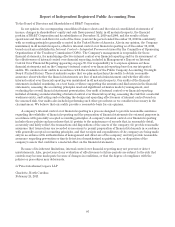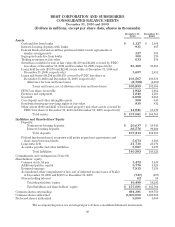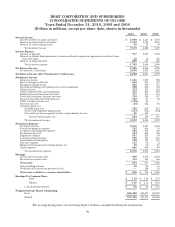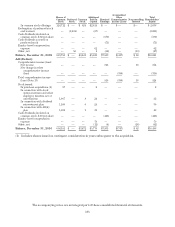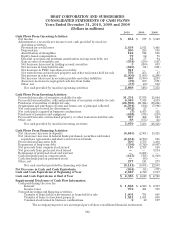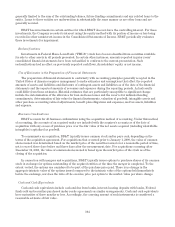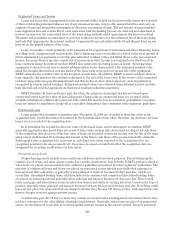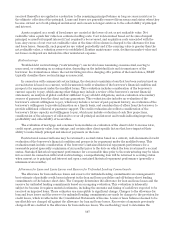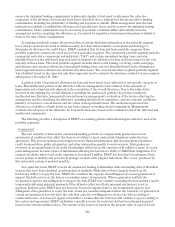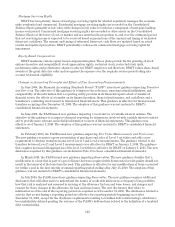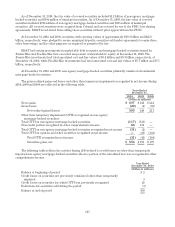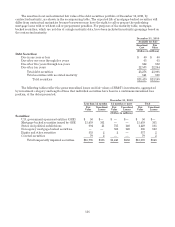BB&T 2010 Annual Report Download - page 106
Download and view the complete annual report
Please find page 106 of the 2010 BB&T annual report below. You can navigate through the pages in the report by either clicking on the pages listed below, or by using the keyword search tool below to find specific information within the annual report.
Originated Loans and Leases
Loans and leases that management has the intent and ability to hold for the foreseeable future are reported
at their outstanding principal balances net of any unearned income, charge-offs, unamortized fees and costs on
originated loans and unamortized premiums or discounts on purchased loans. The net amount of nonrefundable
loan origination fees and certain direct costs associated with the lending process are deferred and amortized to
interest income over the contractual lives of the loans using methods which approximate the interest method.
Discounts and premiums are amortized or accreted to interest income over the estimated life of the loans using
methods that approximate the interest method. Commercial loans and substantially all installment loans accrue
interest on the unpaid balance of the loans.
Lease receivables consist primarily of investments in leveraged lease transactions and direct financing leases
on rolling stock, equipment and real property. Direct financing lease receivables are stated at the total amount of
future minimum lease payments receivable plus estimated residual values and initial direct costs, less unearned
income. Leveraged leases are also carried net of non-recourse debt. Income is recognized over the lives of the
lease contracts using the interest method. BB&T also enters into operating leases as lessor. Operating lease
equipment is carried at cost less accumulated depreciation and is depreciated to the estimated residual value
using the straight-line method over the lesser of the lease term or projected economic life of the equipment.
BB&T estimates the residual value at the inception of each lease. In addition, BB&T reviews residual values at
least annually, and monitors the residual realizations at the end of the lease term. If the review of the estimated
residual values indicates potential impairment and this decline is other-than-temporary, such impairment is
recognized in current period earnings. Estimated residual values are evaluated using information that includes
both internal and external appraisals and historical residual realization experience.
BB&T classifies all loans and leases past due when the payment of principal and interest based upon
contractual terms is greater than 30 days delinquent. Charge-offs on commercial loans are recorded when
available information confirms the loan is not fully collectible and the loss is reasonably quantifiable. Consumer
loans are subject to mandatory charge-off at a specified delinquency date consistent with regulatory guidelines.
Purchased Loans
Loans acquired in a business acquisition after December 31, 2008 are recorded at their fair value at the
acquisition date. Credit discounts are included in the determination of fair value; therefore, an allowance for loan
losses is not recorded at the acquisition date.
In determining the acquisition date fair value of purchased loans, and in subsequent accounting, BB&T
generally aggregates purchased loans into pools of loans with common risk characteristics. Expected cash flows
at the acquisition date in excess of the fair value of loans are recorded as interest income over the life of the loans
using a level yield method if the timing and amount of the future cash flows of the pool is reasonably estimable.
Subsequent to the acquisition date, increases in cash flows over those expected at the acquisition date are
recognized as interest income prospectively. Decreases in expected cash flows after the acquisition date are
recognized by recording an allowance for loan losses.
Nonperforming Assets
Nonperforming assets include nonaccrual loans and leases and foreclosed property. Foreclosed property
consists of real estate and other assets acquired as a result of customers’ loan defaults. BB&T’s policies related to
when loans are placed on nonaccrual status conform to guidelines prescribed by bank regulatory authorities. The
majority of commercial loans and leases are placed on nonaccrual status when it is probable that principal or
interest is not fully collectible, or generally when principal or interest becomes 90 days past due, whichever
occurs first. Specialized lending loans, which includes both consumer and commercial specialized lending loans,
are placed on nonaccrual status generally when principal and interest becomes 90 days past due. Direct retail
loans, mortgage and sales finance loans are placed on nonaccrual status at varying intervals, based on the type of
product, generally when principal and interest becomes between 90 days and 180 days past due. Revolving credit
loans are not placed on nonaccrual but are charged-off after they become 150 days past due, with unpaid fees and
finance charges reversed against interest income.
Certain loans past due 90 days or more may remain on accrual status if management determines that it does
not have concern over the collectibility of principal and interest. Generally, when loans are placed on nonaccrual
status, accrued interest receivable is reversed against interest income in the current period. Interest payments
106



